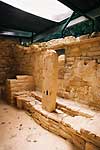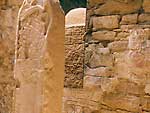Yaxchilán
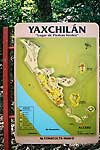 Yaxchilán is remote. It can be accessed
Yaxchilán is remote. It can be accessed only by river launch or small airplane. Tourists will drive or take a
taxi from Palenque to Frontera Corozal and then travel by motorized launch
an hour or two to arrive at the site. We were a curiosity since we were
traveling on the river under our own power - not to mention spending more
than a few hours in the area beyond visiting this first-order archaeological
zone. In fact, we camped the first night on the beach at river's edge
just below the site.
only by river launch or small airplane. Tourists will drive or take a
taxi from Palenque to Frontera Corozal and then travel by motorized launch
an hour or two to arrive at the site. We were a curiosity since we were
traveling on the river under our own power - not to mention spending more
than a few hours in the area beyond visiting this first-order archaeological
zone. In fact, we camped the first night on the beach at river's edge
just below the site.
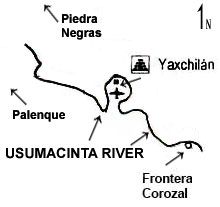
The  archaeological
zone is located on a horseshoe bend in the river in the high hills found
there. It seems to have been an excellent choice of sites on the part
of the original inhabitants. Excavations began only in the last ten years
and more than half of the zone has yet to be investigated. There are numerous
data about the site to be found on the web. See, particularly, the Foundation
for the Advancement of Mesoamerican Studies, Inc and the Center
for the History of Ancient American Art and Culture .
archaeological
zone is located on a horseshoe bend in the river in the high hills found
there. It seems to have been an excellent choice of sites on the part
of the original inhabitants. Excavations began only in the last ten years
and more than half of the zone has yet to be investigated. There are numerous
data about the site to be found on the web. See, particularly, the Foundation
for the Advancement of Mesoamerican Studies, Inc and the Center
for the History of Ancient American Art and Culture .
It is an impressive site considering its age and geography. It was 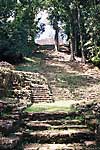 largely
abandoned, as was most of the major Mayan sites, around the end of the
first millenium. Why the entire mayan civilization collapsed at around
the same time is still a great mystery. The common belief is that internecine
warfare broke out among the various city-states such as between Yaxchilán
and Piedras Negras (40 kilometers downriver) leading the survivors to
abandon the centers and literally "head for the hills".
largely
abandoned, as was most of the major Mayan sites, around the end of the
first millenium. Why the entire mayan civilization collapsed at around
the same time is still a great mystery. The common belief is that internecine
warfare broke out among the various city-states such as between Yaxchilán
and Piedras Negras (40 kilometers downriver) leading the survivors to
abandon the centers and literally "head for the hills".
The buildings that remain rise high on bluffs and hills rising in turn
through the jungle and high above the river. Most of the buildings and
stairways leading to them were massive. Much evidence  indicates
that the buildings were plastered and decorated with bas relief and then
painted. The "combs" that decorate the tops of most of the taller
buildings were designed to whistle (probably more of a wail)in high winds.
For the ordinary Mayan living a rural village, a visit must have been
dazzling and awe-inspiring.
indicates
that the buildings were plastered and decorated with bas relief and then
painted. The "combs" that decorate the tops of most of the taller
buildings were designed to whistle (probably more of a wail)in high winds.
For the ordinary Mayan living a rural village, a visit must have been
dazzling and awe-inspiring.
We had just put-in earlier the day we arrived at Yaxchilán. the next day would our first day entirely on the river.
